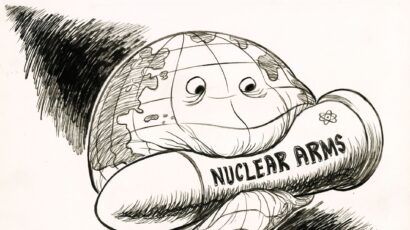Establishing the next president’s national security agenda: Strengthening the civilian instrument
By Gordon Adams | September 8, 2008
The next president will inherit a severe and growing imbalance in the tool kit he has available for dealing with the national security challenges of the early twenty-first century. In the first three parts of this series, I described these challenges and recommended steps to strengthen the White House’s capability to define policy and provide guidance to agencies. I have also underlined the importance of getting defense planning and budgeting under control.
The final task is to repair the decades of damage and disorder that have weakened our civilian instruments of statecraft. As a nation, we have come to rely excessively on the military instruments of power, and have let the weeds grow in the garden of diplomacy and development/foreign assistance. The next Congress and president need to place a high priority on righting this imbalance.
Despite a doubling of U.S. foreign assistance during the past eight years, our development and foreign assistance institutions are too widely dispersed, including a growing number of domestic agencies increasingly engaged overseas.”
Three major problems need attention. First, despite a growing State Department budget during the past eight years, both core diplomacy and public diplomacy are inadequately staffed and funded to play their full role in U.S. foreign and national security policy. Second, despite a doubling of U.S. foreign assistance during the past eight years, our development and foreign assistance institutions are too widely dispersed, including a growing number of domestic agencies increasingly engaged overseas. Our development and assistance efforts need to be better integrated and coordinated; they need a strategic direction; they need more funding and staff; and they need a coordinated budget process. And third, the State Department needs to be given the authority to set policies and budgets for the growing portfolio of foreign and security assistance programs in the Defense Department.
Strengthening State
The State Department is the right place to start rebuilding our civilian capacity. Despite the growth in personnel achieved under Secretary Colin Powell, more staff is needed to cover a growing mission presence overseas; to handle the new agenda of multilateral coalition and organizational growth, economic diplomacy, interagency programs and activities; and to meet the expanding need to interact with nongovernmental actors and businesses overseas. A soon-to-be-released study completed by the Stimson Center for the American Academy of Diplomacy will propose adding personnel to the State Department above currently proposed levels, for both core diplomacy and public diplomacy.
But simply adding more Foreign Service officers to the rolls is not enough. The State Department needs to transform itself to deal with new challenges. The once-dominant Foreign Service culture of “report, negotiate, and represent” is being replaced as current challenges call for wider and more agile engagement. A new breed of diplomat with new skills and new career expectations is needed. This diplomat needs to know how to negotiate, represent, and report, but he or she also needs to know how to shape, implement, and evaluate a foreign assistance program; how to reach out to the public overseas; how to oversee humanitarian assistance in a crisis; and how to support another government as it rebuilds.
Some of this change has already come to State, through mission creep. Diplomats in Washington today are engaged in program planning and oversight in the war on drugs, in African peacekeeping training, in providing counterterrorism assistance overseas, in defining programs to promote democracy, in shaping infectious disease programs, and in providing economic and governance assistance to Central Europe and the former Soviet Union. This mission creep has tightened the connection between diplomats and foreign assistance providers, both in Washington and overseas.
This emerging role for diplomats needs to be reinforced by changes in human resource policies at State and USAID. These agencies need to recruit diplomats who have broad technical, economic, and programmatic skills, as well as cultural and linguistic knowledge. And they have to recruit some of them at mid-career levels, where they can bring those skills to the policy process right away. These diplomats need to be trained throughout their careers, not just at the start of their careers. And this training should include strategic planning, technical subjects, budgeting, economics, management, and especially program development, implementation, and evaluation.
These managers of U.S. foreign policy should be rotated through a range of assignments that reflect the many responsibilities they will have–political, economic, development, administration, public diplomacy, and consular. Careers that have touched on most of the areas of U.S. overseas engagement, including work with other agencies should be rewarded. U.S. global engagement demands a globally savvy work force, and it needs it in the first days of the new administration.
Restructuring foreign assistance
U.S. foreign assistance and development institutions and programs are spread too widely within the federal government to operate effectively. More than 15 agencies and departments provide some kind of foreign assistance within the U.S. international affairs budget, otherwise known as the “150 account.” At least 20 additional federal departments whose budgets are not part of the 150 account are actively engaged overseas, most of them as part of a U.S. embassy country team. At least six programs and budgetary “spigots” support our overseas post-conflict stabilization and reconstruction programs; at least 10 programs and spigots promote governance and democracy; and four more provide humanitarian and disaster relief. The creation of the Millennium Challenge Corporation and the President’s Emergency Program for AIDS Relief in this administration have only added to this organizational diaspora.
This trend, true since the 1950s, must be reversed. A new federal department of development, proposed by some, is not the answer. U.S. economic assistance and our overall strategy of engagement are too closely intertwined to extricate them from one another, and the operating connections already emerging between foreign assistance providers and diplomats are vitally important to maintain. Development should be an objective of our statecraft, not a separate department.
To be effective instruments of statecraft, foreign assistance programs and development need enhanced visibility and adequate staffing and funding. During the past 30 years, USAID’s U.S. workforce has shrunk from 4,300 to 2,200, while the resources it oversees have more than doubled. It has new, more complex assistance relationships with State and especially with the Defense Department in such areas as Iraq and Afghanistan. And it is increasingly working with the private sector, international organizations, nongovernmental organizations, and foreign government assistance agencies.
To cope, USAID has hired private contractors to hold positions that were once civil and Foreign Service jobs, and it has become largely a contract management agency for hundreds of private companies that implement U.S. foreign assistance. Additional personnel are desperately needed. The forthcoming Academy/Stimson study will recommend that the United States double the current overseas staffing levels of USAID, at the very least. And much of that additional staff needs the kind of cross-agency training and experience I have already recommended.
Assistance and development also need greater coordination, coherence, and visibility. The next Secretary of State should start by formally appointing a second deputy secretary of state who would handle management and resources and serve as the administrator of USAID. He or she should be responsible for overall budgeting and management of State/USAID, with specific responsibilities for the coordination of foreign assistance budget planning. As a formal deputy, this person would sit in on all National Security Council meetings, giving a significantly amplified voice to foreign assistance and development. And as a confirmed position, this deputy would be accountable to Congress for most U.S. foreign assistance programs.
If run properly, this deputy’s office would build on the progress made during the past decade to more coherently plan for foreign assistance. It would also ensure that field missions and embassies are an integral part of the planning process and build a more trusting relationship with Congress with respect to assistance programs. (In “Establishing the next president’s national security agenda: The role of the White House,” I proposed that this office play the key role in a coordination of government-wide foreign assistance and development programs taking place in the White House.)
Ensuring foreign policy oversight
As I have previously suggested, it is time to end the Defense Department’s mission creep, a point acknowledged by Defense Secretary Robert Gates this past July. Understanding the differing authorities and capabilities of our civilian and military efforts is a key issue. At the start of the new administration, the president should review the portfolio of foreign assistance programs at Defense, with the objective of returning policy and budget authority to many of these programs to State, which has historically had this responsibility and operates a number of parallel programs. Four programs, in particular, should be put under State:
- The Defense Department’s global program to train and equip foreign security forces (which began in Iraq and Afghanistan) should be carried out under State’s peacekeeping operations and foreign military training authorities.
- The U.S. subsidy of foreign governments that provide support for counterterrorism operations (particularly Pakistan and Jordan) should be carried out under State economic assistance authorities and be overseen by regional bureaus.
- The Defense Department’s education and training program for counterterrorism forces in other countries should be part of State’s International Military Education and Training program.
- Most importantly, Defense and the military should not be in the reconstruction, governance, and development business. These are not military missions, Defense lacks core competence in these areas, and the results of Defense development programs are too often unsustainable in the recipient countries.
This last recommendation would require a major restructuring of the Commander’s Emergency Response Program, developed by Defense for operations in Iraq. Defense is currently seeking expanded, permanent, and global authority for this program. Instead of granting permission to this request, Congress should restrict Defense involvement in reconstruction, governance, and development projects to work conducted in combat zones where civilian assistance providers cannot go. This Defense program should not be made global and permanent, but rather be created and funded on a case-by-case basis.
To handle such responsibilities, State does not need to create a massive civilian intervention corps. In fact, the current proposal to beef up State’s new Office of the Coordinator for Reconstruction and Stabilization is somewhat off course. It makes sense for State to have an office overseeing these types of programs, but they should be part of the new responsibilities of USAID and should build on its existing programs and capabilities for conflict management, civil-military cooperation, and support for government transitions overseas. As I have suggested elsewhere, overall interagency coordination for reconstruction assistance in conflict situations should be in the White House, not at State.
These structural and process reforms in the civilian institutions may seem to be in the weeds, but they are the kinds of changes that need to happen early in the next administration and will be absolutely essential for its foreign and national security policies to succeed. U.S. civilian institutions urgently need empowerment, reform, funding, and coordination. And they need it soon, not four or eight years down the line. If we fail to make these changes soon, the end result is likely to be the further militarization of foreign and security policy, a decline in our civilian capability, and a global community uneasy about U.S. global objectives and capacities.
Together, we make the world safer.
The Bulletin elevates expert voices above the noise. But as an independent nonprofit organization, our operations depend on the support of readers like you. Help us continue to deliver quality journalism that holds leaders accountable. Your support of our work at any level is important. In return, we promise our coverage will be understandable, influential, vigilant, solution-oriented, and fair-minded. Together we can make a difference.
Topics: Columnists















